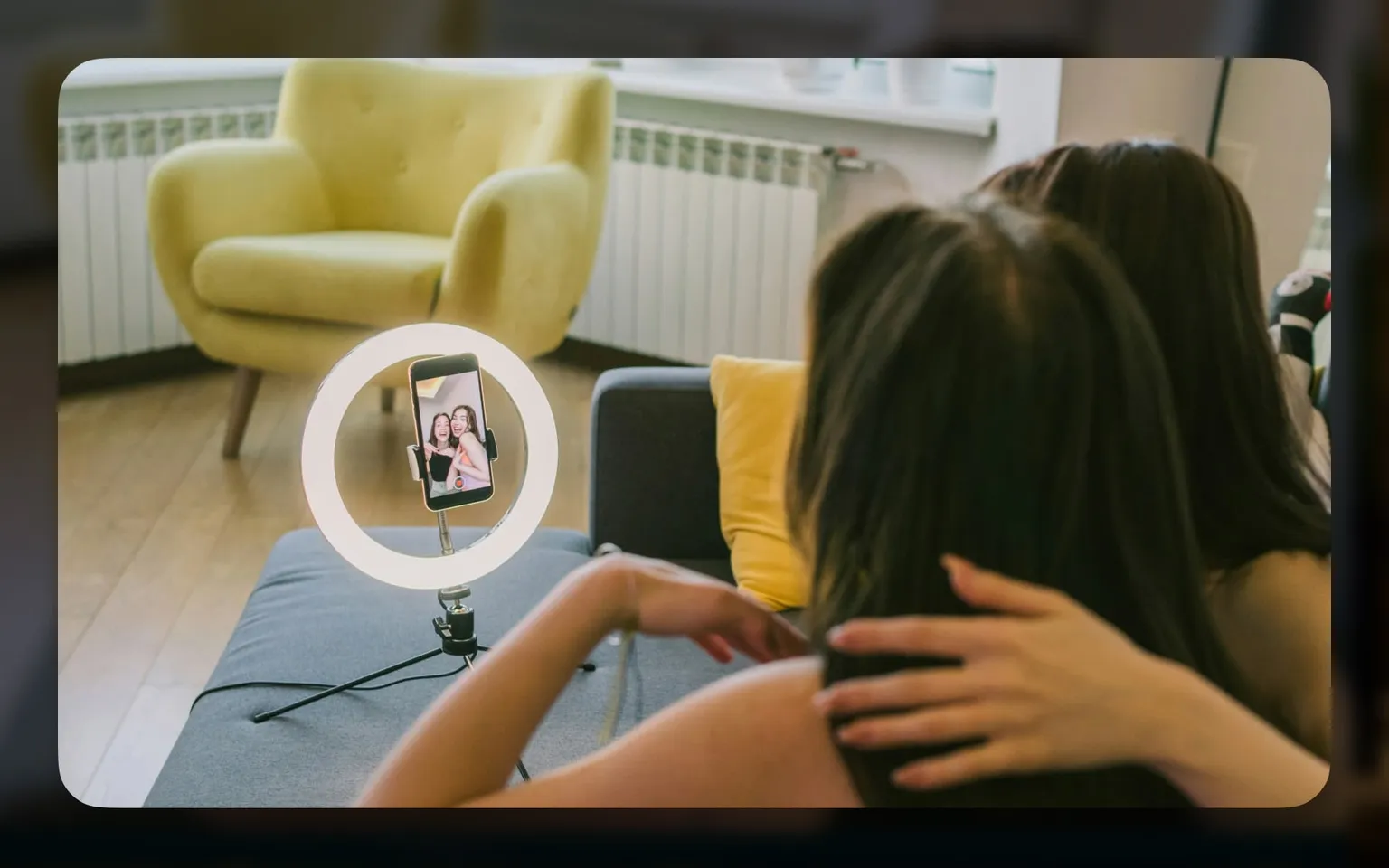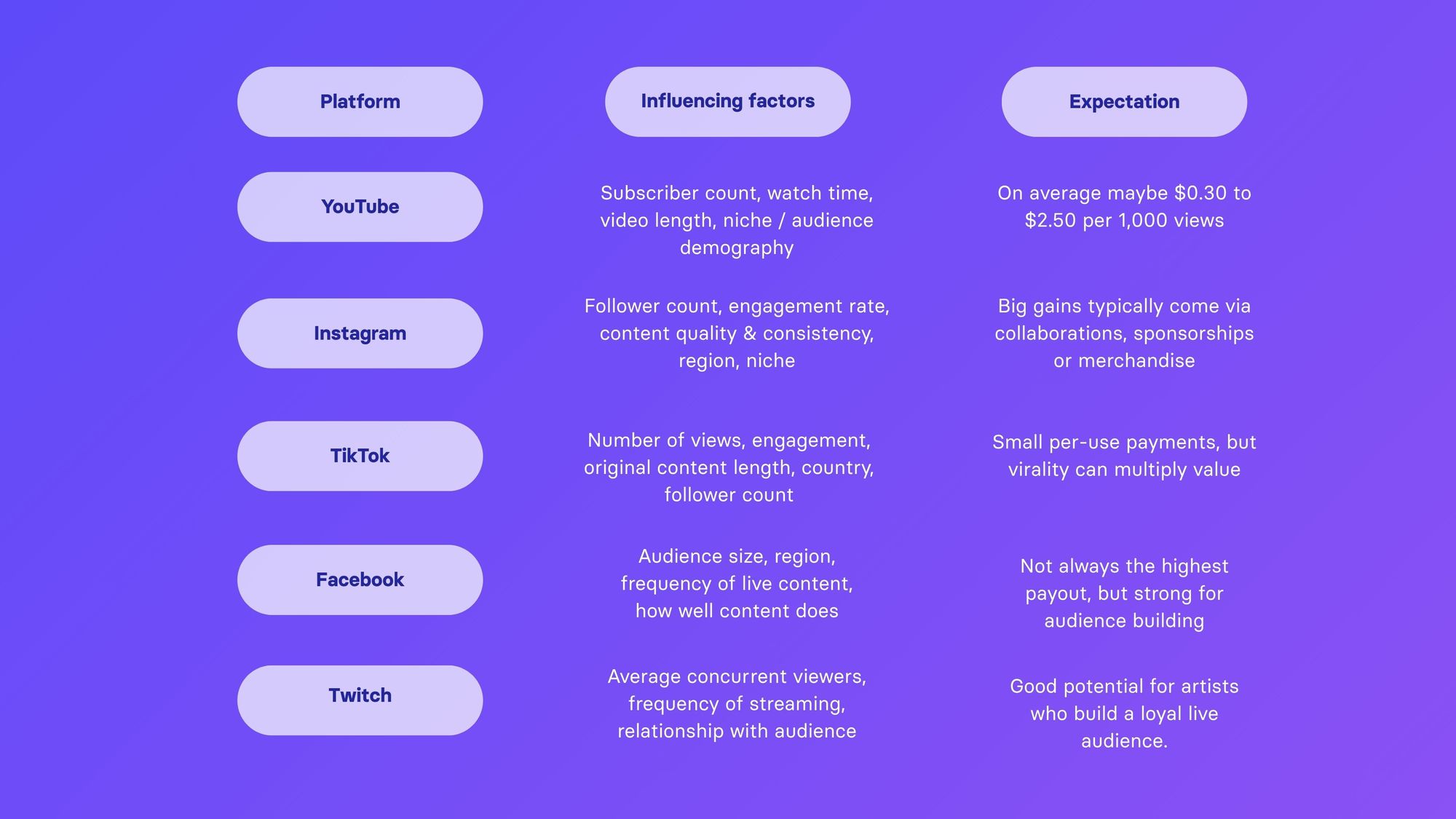How much do musicians really earn from social media? A complete guide to the most profitable platforms

Social media has completely transformed the music industry. What started as a way for artists to share their work and connect with fans has evolved into a powerful ecosystem where creativity meets monetization. For musicians, whether independent or signed to a label, platforms like YouTube, TikTok, Instagram, Facebook, and Twitch are no longer just promotional tools. They are actual revenue streams that can significantly impact a career.
But how much do social media platforms really pay musicians? The answer depends on several factors: the platform itself, the type of content, audience engagement, and the strategies artists adopt. In this guide, we’ll explore how each major platform pays musicians, what influences earnings, and which channels are proving to be the most profitable.
WHat we're going to talk about:
- Why social media matters for musicians today
- How different platforms pay musicians
- Which platform pays the most?
- Emerging trends in music monetization on social media
- How musicians can maximize their social media income
Why social media matters for musicians today
In today’s digital landscape, a musician’s career is almost inseparable from social media. These platforms play three essential roles:
1. Affordable promotion and visibility
In the past, artists needed record label connections, costly PR campaigns, or radio airplay to be discovered. Now, TikTok and Instagram Reels allow independent musicians to reach global audiences with just a smartphone and a creative idea. Even without a big marketing budget, an artist can build visibility, connect directly with fans, and compete with mainstream names.
2. The power of viral discovery
Social media thrives on trends, and music often drives them. A catchy beat on TikTok, a creative challenge on Instagram, or a unique video concept on YouTube can propel an unknown artist into the spotlight overnight. Viral moments have launched entire careers, turning bedroom producers into international stars.

3. Monetization opportunities
Beyond exposure, social platforms now offer direct income streams. From ad revenue and royalties to fan subscriptions, donations, and merchandise sales, musicians can turn engagement into tangible earnings. The key lies in understanding how each platform works and diversifying income sources.
How different platforms pay musicians
Not all social networks are created equal when it comes to monetization. Each one has its own rules, algorithms, and payout models. Here’s a breakdown:
YouTube
YouTube is often considered the most profitable platform for musicians. Through the YouTube Partner Program, creators earn from ads displayed on their videos. Musicians also benefit from Content ID, which pays royalties when other users upload content featuring their music.
Additional revenue streams include channel memberships, merchandise shelves, and Super Chats during livestreams. The actual payout depends on factors like audience demographics, video length, and ad categories. On average, creators earn between $0.30 and $2.50 per 1,000 views, though certain niches can earn significantly more.
Discover how to monetize your Youtube channel as a musician by reading the full article on our blog!
TikTok
TikTok has quickly become the go-to platform for music discovery. When a song trends on TikTok, it often translates into streaming success on Spotify, Apple Music, and YouTube. Musicians earn royalties when their music is added to the platform’s audio library.
Additionally, TikTok runs the Creator Rewards Program, which pays for eligible videos. Payments depend on views, engagement, and content quality. Roughly, artists can expect around $0.03 for each use of their track and between $0.40–$1.00 per 1,000 views for longer, original videos.
Owned by Meta, Instagram pays musicians primarily through royalties on Reels and Stories when tracks are added by users. There are also opportunities to earn through branded content, affiliate links, Instagram Live (with fan “badges”), and Instagram Shopping for merchandise.
Direct payouts from Meta are relatively low, but Instagram shines as a marketing and brand collaboration hub. For many artists, the real money comes not from Instagram itself but from partnerships, sponsorships, and fan-driven sales.
Like Instagram, Facebook has licensing deals that pay royalties when music is used in videos. Artists can also earn through “Stars” during livestreams, fan subscriptions, and ad revenue from eligible content. While individual payouts aren’t as high as YouTube, Facebook’s massive global reach makes it a useful tool for audience building and steady supplemental income.
Twitch
Twitch, primarily known for gaming, has become a powerful platform for live music performances. Musicians can earn through monthly subscriptions (ranging from $4.99 to $24.99), viewer donations using Bits, and ad revenue. The percentage artists keep is usually 50% to 70% of subscription fees. For musicians who thrive in live performance and direct fan interaction, Twitch can be a game-changer.

Which platform pays the most?
When comparing earnings per view, YouTube typically offers the highest returns thanks to its established advertising system and Content ID royalties. However, relying on a single platform can be risky. Algorithms change, policies evolve, and monetization models shift.
The most successful artists diversify across multiple platforms, combining YouTube ad revenue, TikTok exposure, Instagram brand deals, Facebook fan subscriptions, and Twitch donations.
This not only increases income but also ensures greater stability over time.
Emerging trends in music monetization on social media
The future of social media payments for musicians is evolving rapidly. Some key trends to watch include:
- Direct-to-fan monetization: more platforms are introducing fan subscriptions, exclusive content options, and integrated tipping systems that allow artists to earn directly from their audience.
- AI and music licensing: with artificial intelligence increasingly generating or remixing music, new licensing models will emerge to ensure fair compensation for artists whose work inspires AI outputs.
- NFTs and token-based economies: some artists are experimenting with NFTs, allowing fans to invest in songs, unlock exclusive experiences, or share in the success of a release.
- Virtual concerts and immersive experiences: as VR and AR technologies grow, musicians may host virtual shows with ticket sales, digital merchandise, and interactive fan engagement.
How musicians can maximize their social media income
To make the most of social media, musicians should adopt a multi-platform strategy and focus on building an engaged community. Some practical tips include:
- Diversify your income streams: don’t rely solely on ad revenue. Explore royalties, merchandise, fan funding, live events, and collaborations.
- Engage with your audience: the more fans feel connected to you, the more likely they are to support through donations, purchases, and subscriptions.
- Stay consistent and creative: algorithms reward regular posting and innovative content.
- Keep up with updates: social media platforms frequently introduce new monetization tools, be among the first to use them.
Matchfy's VIP Plan
One of the newer, increasingly used tools is Matchfy and specifically its VIP Plan option. This is worth a closer look, because it shows how artists are now combining traditional and newer promotion tactics to maximize exposure and revenue.
Here’s how the VIP Plan works, what it offers, and what to expect:
What is Matchfy & what the VIP Plan does
- Matchfy is a platform that connects artists with playlist curators (especially on Spotify). It helps artists pitch their tracks to playlists that match their genre and sound.
- The VIP Plan is a premium promotion service that gives additional advantages in reaching audiences, pushing songs, and maximizing visibility via multiple platforms (Spotify, TikTok, YouTube) and playlist pitching

Conclusions
Social media has become one of the most powerful engines for a musician’s career, offering not only exposure but also real opportunities for financial growth. Platforms like YouTube, TikTok, Instagram, Facebook, and Twitch all provide different ways to earn: from ad revenue and royalties to live streaming, fan support, and branded collaborations. The truth is that no single platform guarantees success on its own; the real strength lies in a combined strategy where visibility, consistency, and fan engagement work together to generate sustainable income.
At the same time, tools like Matchfy’s VIP Plan can make a crucial difference. While social platforms open the doors, Matchfy helps artists walk through them faster by boosting their tracks on playlists, increasing reach across multiple channels, and offering structured support to maximize promotional campaigns. In other words, if social media is the stage, Matchfy is the spotlight that ensures your music doesn’t go unnoticed.

